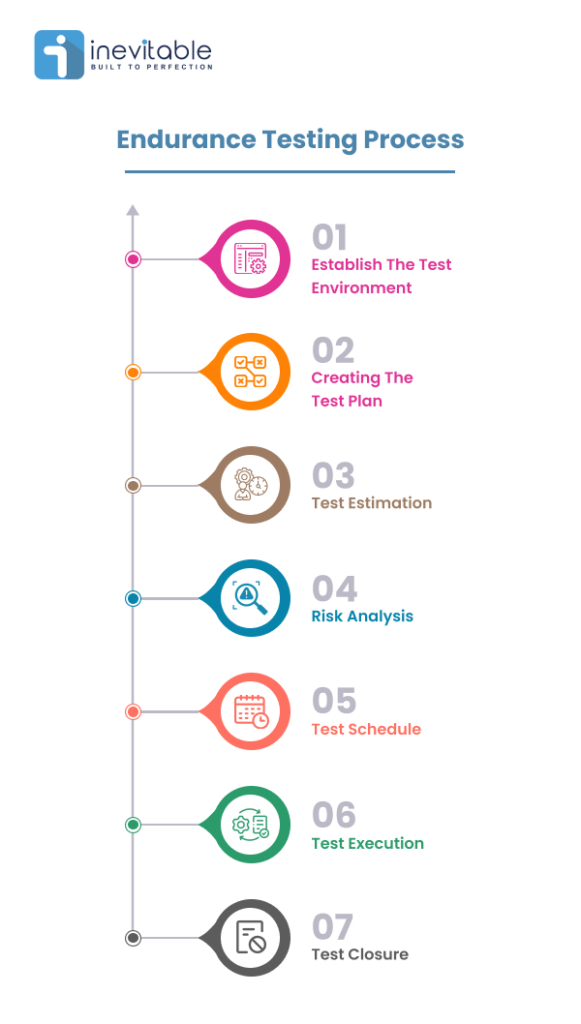Contents
- What is the definition of Endurance Testing?
- What is the objective of Endurance Testing?
- In Endurance Testing, what aspects should be monitored?
- Endurance Testing Process:
- Endurance testing examples
- What are the tools used in Endurance Testing?
- What are the advantages and disadvantages of Endurance Testing?
- Summary

Endurance Testing refers to tests in which software or an application is examined to determine whether it can endure processing load for a long period. Memory consumption is the key factor during these tests. It determines whether there is any potential flaw in the software or not. Endurance testing is done to ensure the performance quality of the software, and in case of bottlenecks, solve them to enhance the system.
For example, for the most complex of errors that can happen to software, like memory leaks, database server utilization, unresponsive system or system failure, etc. endurance testing is done to ensure they do not pertain to ruin end-user experience. It is very similar to stress testing where the system’s limits are tested, but in the case of Endurance Testing, the limits are tested for overtime or overuse of the software.
To summarise, the main purpose of this test is to understand how long a system can handle either prolonged usage a large number of users, or both at a given point in time.
What is the definition of Endurance Testing?
Endurance testing is defined as the type of software testing where the system’s capacity to handle prolonged usage or lead is determined. It is also known as Soak Testing or Longevity Testing as it is done in the last phase of the software development cycle. In this type of testing the system is subjected to heavy load for hours or sometimes, for days. After that, it is monitored to check if there have been any errors. In case of errors, they are recorded and handled by the team of developers. In case of no errors, the software gets a green signal as it is considered to be ready for end-users.
What is the objective of Endurance Testing?
Here are all the different objectives of Endurance Testing:
- To check for memory leaks
- To check the system’s performance under prolonged usage
- To determine the number of users or hours a system can perform at a given point in time
- To determine how much the system is prepared for future loads
- To evaluate the consequences of overloading or underloading of the system
- To prevent complex errors like memory leaks, unresponsive systems, etc.
In Endurance Testing, what aspects should be monitored?
Various components are monitored during Endurance testing, let us have a look at them one by one:
1. Memory Leakage
This is the primary objective of Endurance Testing. For a lot of applications, memory leakage causes the system to crash. To prevent such situations endurance testing is done on the software.
2. Connection between layers of the system
Testing software for a long period helps determine how well the layers of the system are connected. For systems with unclosed connections, modules may get stalled.
3. Connection between Databases
Database connections should always be closed to avoid the crashing of the system. Endurance testing helps determine the same and identify the unclosed connections in the database.
4. Test Response Time
Sometimes, overuse of a system can lead to the deterioration of a system’s response time. Endurance testing helps in understanding the system’s performance and response time for the same.
Endurance Testing Process:

There are these must-have rules or steps to perform endurance testing. Let’s have a look at them:
Step 1: Establish the test environment
It is very important to first identify the hardware, software, operating systems, and other essential aspects of the software to be tested. Based on that the test environment must be built to support the whole process.
Step 2: Creating the test plan
Now it is important to determine the nature of the test that is to be performed. Whether it is automated or it is manual, based on, the test design, reviews, and execution are planned. This whole process comes under the second step of creating the test plan.
Step 3: Test estimation
Since endurance testing is a long process involving a lot of hours and a workforce, it is important to have an estimate of the time required. Determine the number of cycles and hours that are required for the given software and provide an estimation for the test.
Step 4: Risk Analysis
Before the test execution starts one crucial step is to analyze risk factors like Will the performance remains consistent over time. Is there a possibility that there are some minor errors that have not been detected yet? Factors like these can hamper the test mid-way and cause a major waste of time and labor. Hence, it is advised to take this step as a serious consideration before the execution begins.
Step 5: Test Schedule
It is very important to schedule the tests according to their requirements, urgency, risk factors, and other deliverables.
Step 6: Test Execution
The execution of the tests comes as the second last step in the process. Nevertheless, it is the longest step in the process. In this step make sure to constantly keep a check on the test process to avoid any unforeseen circumstances.
Step 7: Test Closure
Once the execution is done, the remaining tasks are mostly related to recording the outcomes. In case of any errors surfacing from the tests, they are analyzed and sent to the developers to work on it. Otherwise, the product is deemed fit and set ready to be released in the market.
Endurance testing examples
Here is an example of Endurance Testing as follows:
Memory Leakage:
Memory leakage refers to one of the most common problems faced by developers in the world of software. It happens when the software breaks owing to the overload of information that is no longer in use. It usually happens due to the vulnerable writing of the code by the developers. Here is one real-life example to give you a better understanding:
Let’s assume there has been a lockdown and the banks have shut down. The users of these banks will switch to the applications on these banks to continue their daily transactions. This sudden change in the situation will create an upsurge in the online traffic for these applications. The moment they will overload they will break and give out confidential information of its users.
To avoid such dire circumstances the software should be prepped and updated and an endurance test must be performed on it to ensure that the software is robust, secure, and high-performing.
What are the tools used in Endurance Testing?
1. WebLOAD
WebLOAD is a bottleneck identification tool, that comes with a 30-day free trial. QA testers can make use of this tool for other purposes like application management, continuous integration, and more.
2. LoadComplete
It is a tool that is best known for its server evaluation characteristics like the number of concurrent requests, number of database transactions, and more.
3. Apache JMeter
Apache JMeter is an open-source multi-purpose QA tool that can mostly perform all sorts of quality assurance testing that are there.
4. LoadRunner
It is also a versatile tool that comes with various other features like Data Analytics, Vugen Enhancements, Load Testing, Modelling, and more.
What are the advantages and disadvantages of Endurance Testing?
Though endurance testing is a vital part of the software development life cycle, it also comes with a lot of advantages and disadvantages. Here are the pros and cons of Endurance Testing in Software Testing:
| Advantages of Endurance Testing | Disadvantages of Endurance Testing |
| Helps identify memory leakage | It is the most time-consuming software testing process |
| It reduces the possibility of paying high maintenance costs later | Selecting the right automation tool is very important to fetch results without any discrepancies |
| Identifies performance issues in any | Sometimes over-stressing can cause performance issues to rise |
| Hidden bugs can be easily detected in this process | May not be efficient to cover all the possible scenarios |
| Very costly as it may require a specialized workforce and advanced tools | Very costly as it may require specialized workforce and advanced tools |
Summary
So to wrap it up, Endurance testing or Soak testing is a crucial part of the software development life cycle. It is usually performed at the end of the software development. It takes a lot of time, effort, money, and resources to carry out this set of tests. However, it is an important test to understand the workload capacity of software under sudden increase or decrease in traffic for a prolonged amount of time.




